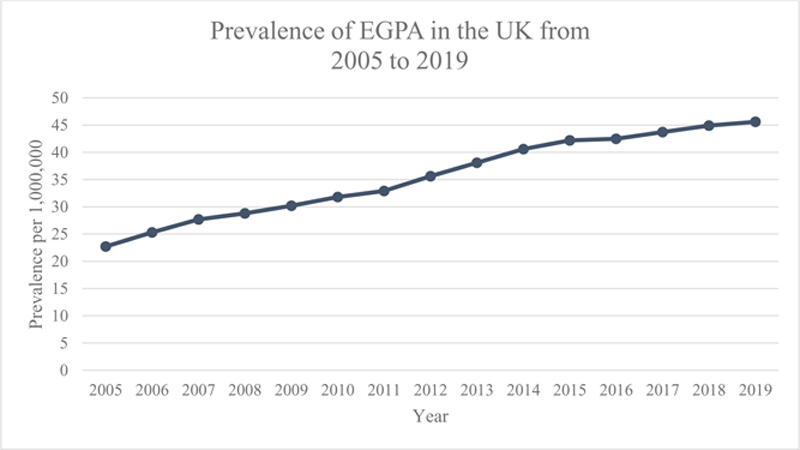

Background: Eosinophilic granulomatosis with polyangiitis (EGPA) is characterized by eosinophilic inflammation of small with or without medium arteries. EGPA is a rare disease with varying prevalence and incidence rates globally. To date, limited information is available on the prevalence, incidence and burden of disease in the United Kingdom (UK).
Objectives: The objectives were to estimate the prevalence and incidence of EGPA, and to describe the healthcare resource utilization (HCRU) among patients with EGPA in the UK.
Methods: This retrospective database study used the UK-based Clinical Practice Research Datalink (CPRD)-AURUM database linked to the Hospital Episode Statistics (HES). Prevalence was estimated from 2005 to 2019, and incidence was estimated from 2006 to 2019. HCRU was assessed in the 12-months following the first recorded diagnosis of EGPA (index date), and included hospitalizations, emergency room visits, procedures, outpatient specialist visits, primary care visits, and oral corticosteroid use.
Results: 764 people were identified with EGPA in the UK. The prevalence of EGPA, reported in the database, increased from 22.7 to 45.6 per 1,000,000 persons from 2005 to 2019 (
HCRU among patients with EGPA
| HCRU | Number of patients N (%) [total days] | Number of events per patient, Mean (SD) |
|---|---|---|
| Total EGPA cohort (N) | 377 | |
| EGPA-specific hospitalizations | 72 (19.10) | 1.2 (1) |
| EGPA-specific hospitalizations length of stay | [1283] | 17.8 (23.3) |
| Any-cause hospitalizations | 188 (49.87) | 1.7 (1) |
| Any-cause hospitalizations length of stay | [2992] | 15.9 (23.7) |
| Any-cause A & E events | 19 (5.04) | 1.8 (2) |
| Any-cause outpatient visits | 334 (88.59) | 9.8 (7) |
| Any procedures undertaken | 196 (51.99) | 6.8 (6) |
| General Practitioner visits | 366 (97.08) | 16.0 (11) |
A&E, Accident and Emergency; EGPA, eosinophilic granulomatosis with polyangiitis; HCRU, healthcare resource utilization.
Prevalence of EGPA in the UK from 2005 to 2019
Prevalence is expressed as cases per 1,000,000 persons. EGPA, eosinophilic granulomatosis with polyangiitis; UK, United Kingdom.

Conclusion: The prevalence of EGPA increased over the study period in the UK, and the data show significant HCRU within 1 year of the first recorded diagnosis of EGPA. Almost all of the patients with EGPA were found to frequently visit the primary care physician and seek specialist care, and almost half required hospitalization. Funding: GSK [207888]
Acknowledgements: Funding: GSK [207888]
Disclosure of Interests: Jeremiah Hwee Shareholder of: GSK, Employee of: GSK, Qinggong Fu Shareholder of: GSK, Employee of: GSK, Lorraine Harper Speakers bureau: Viopharm (2021), Roche (2017), Consultant of: GSK (2021), Viopharm (2021), Grant/research support from: Viopharm (researcher initiated project), MSD (researcher initiated project), Krishnarajah Nirantharakumar Consultant of: Boehringer Ingelheim (Consultancy on real world evidence), Grant/research support from: AstraZeneca, Vifor and Boehringer Ingelheim (Investigator led grants), Ruchika Goel: None declared, Rupert Jakes Shareholder of: GSK, Employee of: GSK